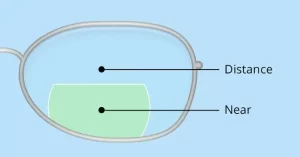I frequently encounter inquiries regarding the distinctions between bifocal and trifocal lenses. In this article, my aim is to provide you with an analysis of the advantages and disadvantages associated with both options. By the end of this discussion, you will be better equipped to make a well-informed choice when selecting your next pair of glasses. Let’s dive into the intricacies of the “Bifocal vs Trifocal” debate.
What are Bifocal Lenses?

Bifocal lenses contain two different lens powers in a single lens. Typically, the upper part of the lens is used for distance vision, while the lower part is used for near vision. This design allows users to switch between near and distance vision by simply looking through different parts of the lens.
Pros of Bifocal Lenses
- Simplicity: Bifocal lenses provide a simple and effective solution for individuals with presbyopia, a common age-related vision problem that makes it difficult to focus on near objects.
- Cost-effective: Bifocal lenses are usually less expensive than progressive lenses, making them a budget-friendly option for many people.
- Wide field of view: The large reading area in the lower part of the lens provides a wide field of view for near tasks, such as reading or sewing.
Cons of Bifocal Lenses
- Visible line: The dividing line between the two lens powers is visible, which can be bothersome for some users and may also be noticeable to others.
- No intermediate vision: Bifocal lenses do not offer correction for intermediate distances, such as computer screens or car dashboards, which can be a drawback for some users.
- Adaptation: It can take time for users to get used to the transition between the two lens powers, and some may experience temporary eye strain or discomfort.
What are Trifocal Lenses?

Trifocal lenses have three distinct lens powers in a single lens: one for distance vision, one for intermediate vision, and one for near vision. This design allows users to have clear vision at all distances without having to switch between different pairs of glasses.
Pros of Trifocal Lenses
- Versatility: Trifocal lenses provide clear vision at all distances, making them an ideal choice for individuals with multiple vision needs.
- Intermediate vision: Unlike bifocal lenses, trifocal lenses have a dedicated intermediate zone, which can be beneficial for those who spend a lot of time working at intermediate distances.
- Easier adaptation: Many users find that trifocal lenses are easier to adapt to than progressive lenses, as the transition between the different lens powers is more distinct.
Cons of Trifocal Lenses
- Visible lines: Trifocal lenses have two visible lines dividing the different lens powers, which can be bothersome for some users and may also be noticeable to others.
- Bulkier design: Trifocal lenses are typically thicker and heavier than bifocal or single-vision lenses, which can be less comfortable and less aesthetically pleasing for some users.
- Cost: Trifocal lenses are usually more expensive than bifocal lenses, making them a less budget-friendly option.
Bifocal vs Trifocal Lenses: Choosing the Right One for Your Needs
Factors to consider when choosing between them
When deciding between bifocal and trifocal lenses, there are several factors to consider based on your vision needs and lifestyle. Here are some key points to keep in mind:
1. Prescription: The nature of your vision prescription plays an important role in determining whether bifocal or trifocal lenses are more suitable for you. It’s essential to consult with your eye care professional to determine which option would best correct your specific vision issues.
2. Visual Demands: Consider your daily activities and the visual demands they impose. If you need clear vision at multiple distances, such as reading, working on a computer, and driving, trifocal lenses may be more appropriate. However, if you have a more specific visual need, such as reading or distance vision, bifocal lenses may suffice.
3. Adaptability: Adapting to bifocal or trifocal lenses can take some time, as your eyes need to adjust to the different lens segments. Some individuals find it easier to adapt to bifocals, while others prefer the additional intermediate vision offered by trifocal lenses.
4. Cost: Trifocal lenses typically cost more than bifocal lenses due to their additional lens segment for intermediate vision. Consider your budget and weigh the additional benefits offered by trifocal lenses against their higher cost.
5. Personal Preference: Ultimately, your personal preference should not be overlooked when choosing between bifocal and trifocal lenses. Some people find one type more comfortable or aesthetically pleasing than the other. It’s important to try both options and see which one feels most suitable for your lifestyle.
Remember that consulting with an eye care professional is crucial when making decisions about your vision correction. They can provide personalized recommendations based on your specific needs and ensure you choose the right lenses for optimal visual clarity and comfort.
Conclusion
In conclusion, choosing between bifocal and trifocal lenses depends on the specific needs and preferences of the individual. Here is a summary of the key points to consider when deciding:
| Factors | Bifocal Lenses | Trifocal Lenses |
|---|---|---|
| Vision | Provide clear vision for two distances (near and far). | Provide clear vision for three distances (near, intermediate, and far). |
| Lines | Have a visible line separating the two lens segments. | Have two visible lines separating the three lens segments. |
| Affordability | Can be more affordable than trifocal lenses. | – |
| Range | Suitable for individuals who mainly need correction for near and distance vision. | Suitable for individuals who require clear vision at intermediate distances, such as working on a computer. |
| Benefits | – | Offer a wider range of vision correction. |
It is important to consult with an optometrist or ophthalmologist to determine the best option based on individual eye health and vision needs.

